VegeHub V1 - Quick Start Guide
Before You Start
Warning: Because batteries off-gas acid, especially in hot sealed environments, never place batteries inside the VegeHub enclosure, as this will corrode and destroy the electronics, over time, and void any warranties.
Configure the VegeHub to connect to your local WiFi network
The first step is to configure the VegeHub for access to your local WiFi network.
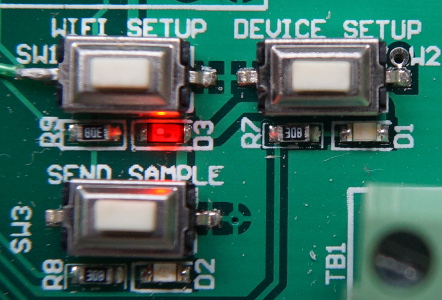
- Hold down the "WiFi Setup" button until its red LED turns on.
- The VegeHub has now created its own WiFi hotspot. Use a phone or laptop to connect to the new WiFi network. It will be named something similar to VEGE_HUB_E4_9B.
- Your phone or laptop may now ask you to log in to the network, this may bring you to the WiFi setup page for the VegeHub. If you are not asked to log in, open a web browser and type in to the address bar : 192.168.1.1.
- After the WiFi setup page appears, click the Refresh button to bring up a list of nearby
WiFi networks.
From the list, click your network. This will automatically fill in your network's name.
Now go to the "pass phrase" field and fill in your network's password, then click Connect. The response web page will be an error page, because the hub immediately disconnects from the network. Your phone or laptop should now automatically disconnect from the hub.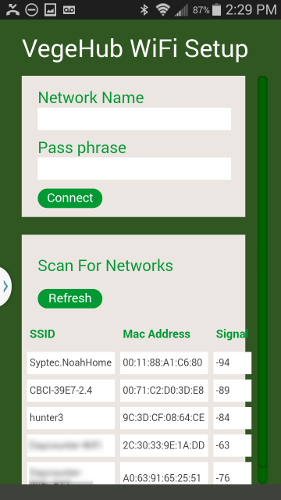
- The VegeHub will now try to connect to your WiFi network. If the red LED is still lit, press the WIFI setup button again, until it turns off.
Determine the IP address of your VegeHub.
Now that your VegeHub has connected to your network. You can set it up to connect to a remote server of your choice.
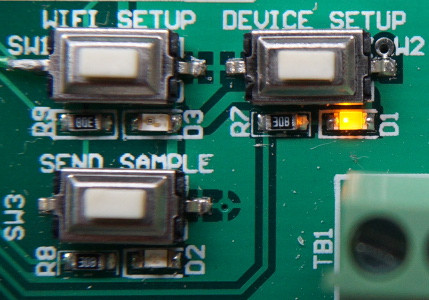
- Hold the "Device Setup" button down until its LED turns on. This place it in device setup mode. After 5 minutes, it will revert back into normal mode, and the "Device Setup LED", will turn off. Please note that if the "Device Setup" LED is not turned on, you will not be able to access the "Device Setup" web page.
- Determine the IP address that your network has assigned to your VegeHub. There are
several ways to do this.
You can download an app for your phone or computer, access the device list on your
router, or you can connect
to the device using a USB cable.
-
Option 1 (Recommended): Using a computer or phone connected to the same network
as the VegeHub, find the IP address of the
VegeHub. The phone app for Fing works well.
In the list
search for a device that has the host name you entered during the WiFi setups
step.
The device will have the manufacturer listed as "Newport Media".
In this example screen shot, you would note that the ip address of the VegeHub is 192.168.0.33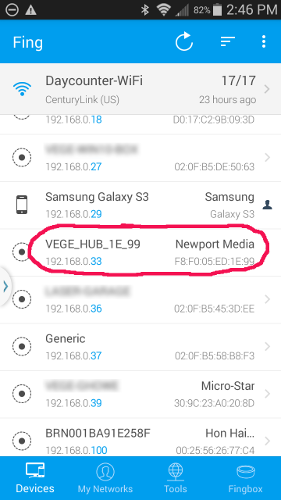
- Option 2: You can also get a list of connected devices by accessing your router's connected device page. The IP address of each device will be displayed.
- Option 3: You can also get the IP address, via the USB port with any serial terminal program such as Putty or termite. Connect to the device using 115200 baud, 8 data bits, DTR/DSR flow control, and no parity. Type the command WiFi and the IP address will be displayed.
-
Option 1 (Recommended): Using a computer or phone connected to the same network
as the VegeHub, find the IP address of the
VegeHub. The phone app for Fing works well.
In the list
search for a device that has the host name you entered during the WiFi setups
step.
The device will have the manufacturer listed as "Newport Media".
Configure the VegeHub
Once you find the IP address (it should look similar to this: 192.168.0.X) type it into the address bar of a web browser of a computer or phone on your local WIFI network. This should bring up the home page of setup webpage for the VegeHub.
VegeHub Home Tab
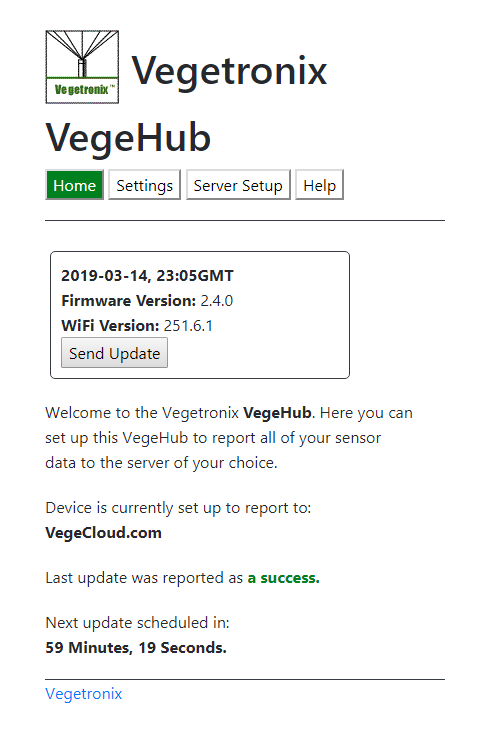
The "Home tab shows the current date and time, and firmware version and WIFI software versions, and lets you know to which server you are currently sending data.
The "Send Update" button allows you to immediately read a sensor and send the sample to the server that you will select in a subsequent step.
VegeHub Settings Tab
Click on the "Settings" tab to view and set the following settings:
- Unique Name - You can enter a unique name for the VegeHub. Other devices on the network such as your router will display this name to reference your VegeHub. Leaving it as the default value is recommended.
- Blink Led - When this box is checked, the green LED will blink once each time the hub connects to the server. Setting this option will reduce battery life slightly, but it is useful for troubleshooting.
- Send Hub Voltage - For applications when the VegeHub is powered by battery, this allows the battery voltage to be sampled and sent to the server along with the samples from the sensor. This allows you to remotely monitor the battery on the VegeHub, and be alerted when it needs to be changed.
- Sensor Power This allows you to apply constant power to the sensor. For battery applications this should only be used for very low current sensors, such as our Vegetronix mailbox sensor. This option is also useful when you are setting up sensors such as the AquaPlumb, which need power to be calibrated.
- Reporting Style - There are two reporting styles:
- Sample Mode This mode allows the VegeHub to periodically wake from sleep,
and read the sensor, and send these samples to your selected server after each
sample
is taken, or in batches to conserve battery life. Most analog sensors will use
this mode.
The following Sample Mode Options are available: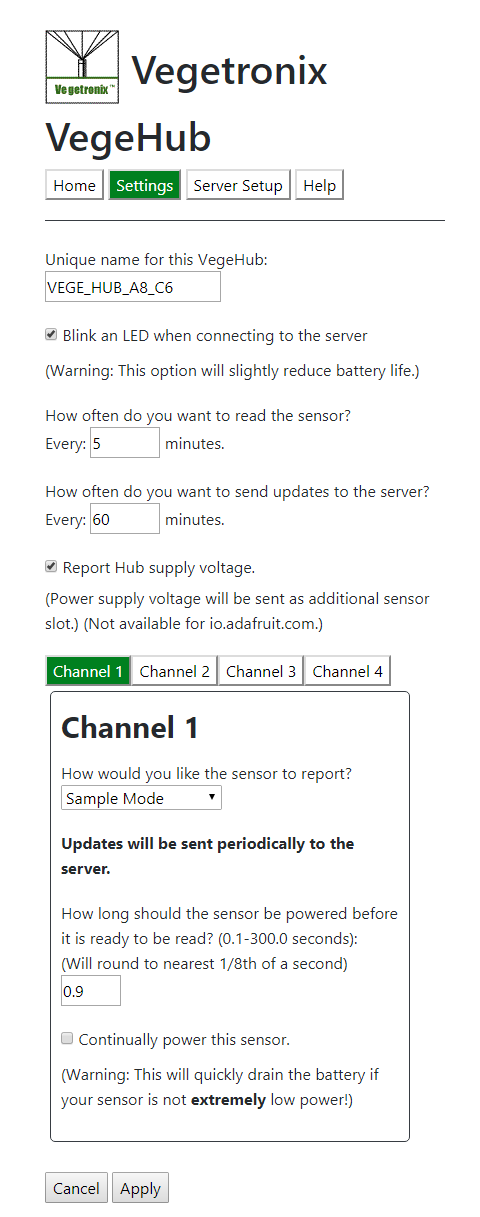
- Sample Period This specifies how often do you want to read the sensor. This setting will affect your battery life, and so you want to use the largest value possible to reduce battery consumption. Many sensors such as moisture sensors only need to be read about once per hour. If you want to read the sensor every hour, the enter 60 for this value. For inital setup and trouble shooting you may want to set this for rapid updates, then after it is working set it to a slower value, to conserve power.
- Update Period This specifies how often the VegeHub connects to your selected server to post data. If this value is the same as the sample period, then it will connect to the server each time it reads a sample of data from a sensor. If this is set to a value larger than the sample period, then it will batch post multiple samples when updating. It is best to set this to a multiple of the sample period value. This also affects battery life. The larger the period, the lower the battery usage. For inital setup and trouble shooting you may want to set this for rapid updates, then after it is working set it to a slower value, to conserve power.
- Warmup Time This specifies the warm up time of the sensor before a reading is taken. Power is normally applied to the sensor only right before a sample is taken, to reduce battery power, however, most sensors need time to power up before they are fully functional. This field specified how long to wait after apply power, before taking a sensor reading. Check your sensor's specification to determine this value. Typical values are 1 second. If the checkbox for the sensor power is set to always on, then this field is ignored.
- Edge Trigger Mode This is a binary mode that allows the VegeHub to be
waken up from
sleep when a sensor has gone from 3V to 0V, or 0V to 3V, and for it to send
notification
to a server.
Use this mode for push button, mailbox sensors, or other binary type sensors,
that are either
on or off. Since the VegeHub only wakes up when a trigger occurs this greatly
increases
battery life.
The following Edge Trigger Mode Options are available: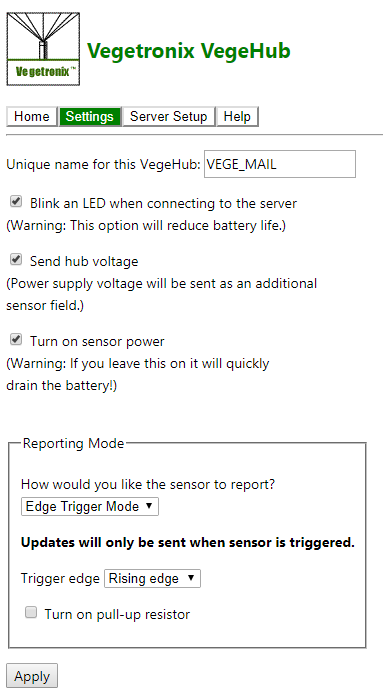
- Trigger Edge Falling means that the sensor's output goes from about 3V voltage to 0V, and raising means that the sensor's output goes from 0V to about 3V.
- Pull-up Resistor Checking this will enable an internal pull up resistor. This would typically be used with a push button. Don't use this option for the mailbox sensor.
- Sample Mode This mode allows the VegeHub to periodically wake from sleep,
and read the sensor, and send these samples to your selected server after each
sample
is taken, or in batches to conserve battery life. Most analog sensors will use
this mode.
VegeHub Server Setup Tab
The server setup tab allows you to connect with 3 popular IoT sites: ThingSpeak.com, io.Adafruit.com, and VegeCloud.com. VegeCloud is a new site, and is in Beta testing. You can also enter in any other server URL, but it must support VegeCloud formated data.
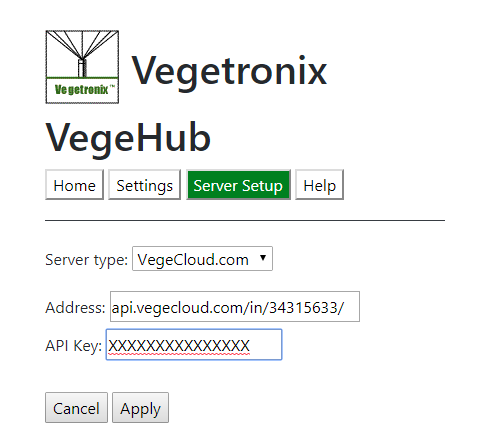
Trouble Shooting
After the VegeHub has been configured to talk to a desired server, it will periodically contact the server, and send its data, according to it's sample rate. Whenever it sends an update, it will blink the green LED. If it is unable to connect to the server, or if there is some other problem, it will blink the red LED instead.
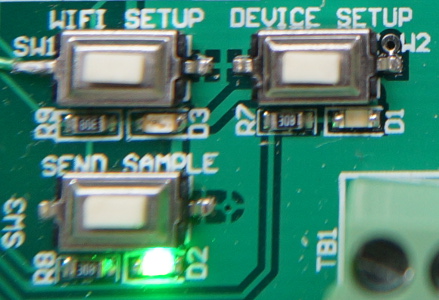
You should be able to see data on the server websites, as updates are sent.
When you are initially getting familiar with the VegeHub, set the sample and update periods to 1, for a high update rate, so that you can more quickly see if you are receiving data. Then after you have everything working, set the sample and update periods to larger values to conserve battery power.
Make sure your router is not blocking the VegeHub with any firewalls.